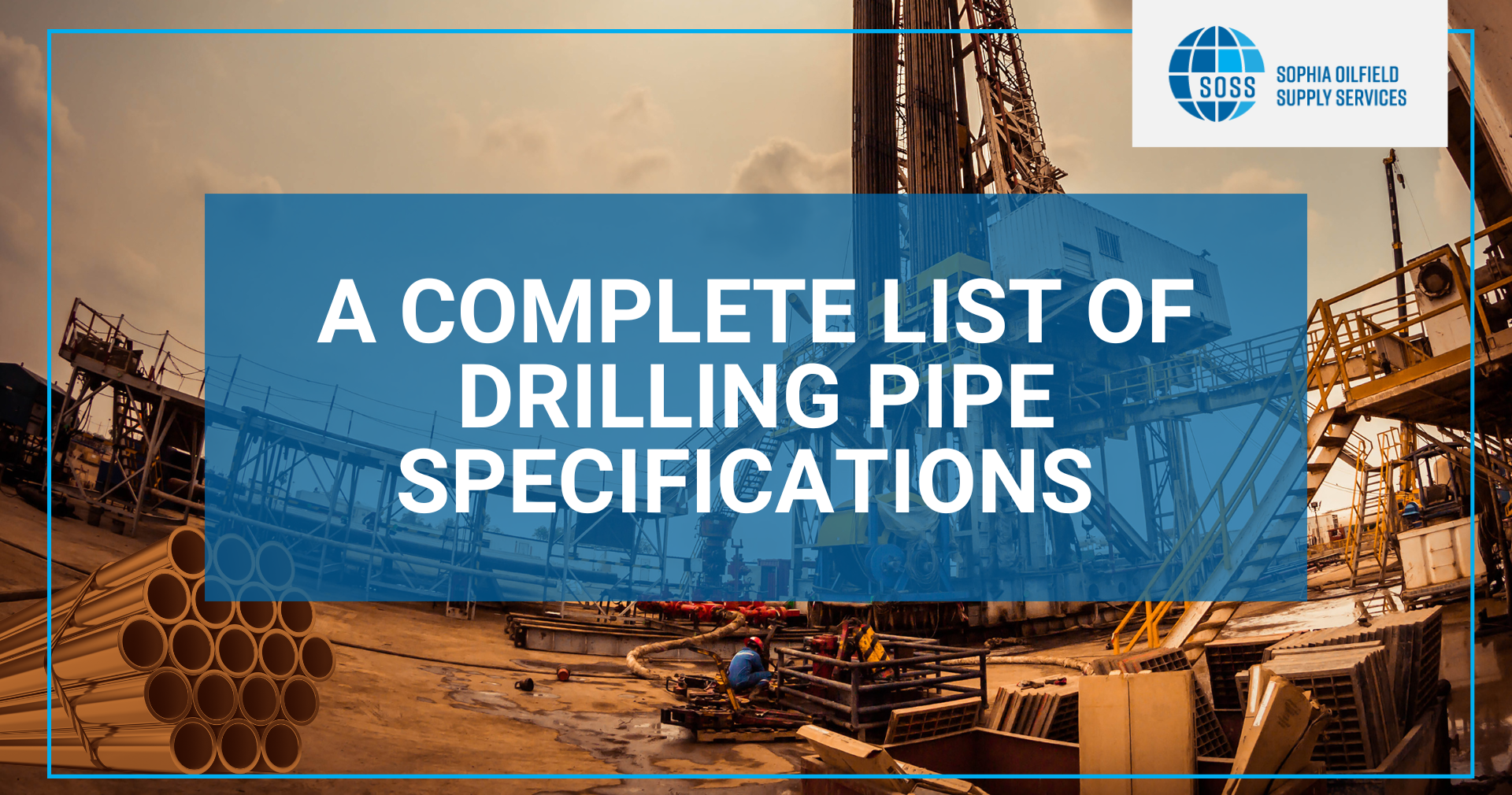Drilling pipe specifications play a pivotal role in ensuring the success and safety of drilling operations across various industries. A drill pipe is an essential tool used in drilling for oil and gas extraction, available in different diameters, lengths, grades, and configurations to suit specific drilling requirements.
These specifications provide crucial details about the design, materials, dimensions, and performance characteristics of drill pipe, which is among the main components of the drilling process.
By adhering to specified standards and parameters, drilling operators can optimize drilling efficiency, mitigate risks, and achieve desired outcomes in exploration and extraction projects.
Let’s explore the significance of drilling pipe specifications in the oil and gas industry and discuss the various parameters that characterize drill pipe.
Specifications
| Outer Diameter (inches) | Nominal Weight (lbs/ ft.) | Grade | Wall Thickness (inches) |
| 2 ⅜ | 6.65 | E, X, G, S | 0.280 |
| 2 ⅞ | 10.40 | E, X, G, S | 0.362 |
| 3 ½ | 13.30 | E, X, G, S | 0.368 |
| 3 ½ | 15.50 | E, X, G, S | 0.449 |
| 4 | 14 | E, X, G, S | 0.330 |
| 4 | 15.70 | E, X, G, S | 0.380 |
| 4 ½ | 16.60 | E, X, G, S | 0.337 |
| 4 ½ | 20 | E, X, G, S | 0.430 |
| 5 | 19.50 | E, X, G, S | 0.362 |
| 5 | 25.60 | E, X, G, S | 0.500 |
| 5 ½ | 21.90 | E, X, G, S | 0.361 |
| 5 ½ | 24.70 | E, X, G, S | 0.415 |
| 6 ⅝ | 25.20 | E, X, G, S | 0.330 |
| 6 ⅝ | 27.70 | E, X, G, S | 0.362 |
| Steel Grade | Yield Strength (psi) | Minimum Tensile Strength (psi) |
| E-75 | 75000-105000 | 100000 |
| X-95 | 95000-12500 | 105000 |
| G-105 | 105000-135000 | 115000 |
| S-135 | 135000-165000 | 145000 |
Types of Drilling Pipe
Drilling operations rely on various types of specialized pipe designed to withstand the demanding conditions encountered during drilling. However, we can categorize a drill pipe into two main types, including a regular drill pipe and heavy heavy-weight drill pipe.
A drill pipe is a long, hollow device serving an essential component of the drill string, transmitting torque and circulating drilling fluid to the drill bit. It weighs between 6 to 43 pounds per foot, depending on factors like wall thickness, length, diameter, material grade, etc.
A heavy-weight drill pipe is similar to a regular drill pipe but is a more robust pipe with greater wall thickness and weight per foot than a standard drill pipe. It lowers stress between the regular drill pipe and drill collar and provides additional weight and stiffness to the drill string, enhancing drilling efficiency, reducing vibration, and minimizing the risk of drill pipe fatigue failure.
A heavy-weight drill pipe is also used to improve the weight transfer to the drill bit, increasing drilling performance in challenging formations.
The high strength pipe has similar outer dimensions to the regular drill pipe and is ideal for high-pressure, high-temperature drilling environments where accuracy and stability are paramount.
Further, we could differentiate between seamless steel pipe and welded steel pipe. The seamless drill pipe is manufactured from a single piece of steel without seams or welded joints, offering superior strength and reliability.
The seamless drill pipe provides smoother surfaces and consistent mechanical properties than a welded pipe, reducing the risk of failures and improving the overall drilling operation.
What Is a Drill Collar?
A drill collar is a thick-walled, heavy, tubular steel pipe near the end of the drill string above the drill bit. The pipe provides weight to the drill bit, aiding in the transmission of weight on the bit for efficient drilling.
Additionally, a drill collar helps maintain verticality and stability in the borehole, reducing buckling and deviation, regardless of whether you are working with an alloy steel pipe, aluminum pipe, or galvanized steel pipe.
Drill Pipe Dimensions
Key dimensions such as outer diameter, inner diameter, and length play critical roles in the performance and compatibility of a drill pipe with the drilling equipment.
Diameter
The outer diameter of a drill pipe typically ranges from 2 3/8 to 6 ⅝ inches. A larger outer diameter increases stiffness and strength, allowing the drill pipe to withstand higher loads and pressures during drilling operations.
A larger inner diameter facilitates efficient fluid flow without resistance, enhancing drilling efficiency and wellbore cleaning.
Length
Length determines drilling depth and equipment reach within the wellbore. Think of it like a hole opener that needs the right drill pipe size to get the drilling fluid to where it needs to go.
Lengths can be classified under three ranges. These include R1, R2, and R3. Most drill pipe lengths fall under range 2, which is about 27 to 32 feet. However, a range three drill pipe, from 38 to 45 feet long, could also be used for deeper drilling.
Therefore, the dimensions of the drill pipe directly affect drilling performance and equipment compatibility in several ways.
Materials
Drill pipe is typically manufactured using materials selected for their strength, durability, and resistance to corrosion. Common materials include high-strength alloy steel, stainless steel, and carbon.
Materials such as alloy and stainless steel offer superior mechanical properties than carbon steel. These include higher tensile strength, yield strength, and hardness. These properties enable a drill pipe to withstand the extreme loads, pressures, and abrasive conditions
encountered during drilling operations, reducing the risk of premature failures and downtime.
Alloy steel, which incorporates various alloying elements such as chromium, molybdenum, and nickel, is widely used in drill pipe construction. It offers enhanced strength to bear pressure and tension and more corrosion resistance.
Stainless steel is also renowned for its exceptional corrosion resistance. The material protects against rust, pitting, and other forms of degradation in corrosive drilling fluids and environments. It is often employed in harsh drilling environments where corrosion is a significant concern.
Carbon steel is known for its hardness and affordability but is less corrosion-resistant than alloy or stainless steel pipe.
Material Grades
Drill pipe is classified by the API (American Petroleum Institute) into four material grades from which it is manufactured, which defines its minimum tensile strength and yield strength. These include, E75, X95, G105, and S135.
Grades X, G, and S have yield strengths of 95,000, 105,000, and 135,000 psi, respectively, and are high-strength steel grades. They are suitable for deeper drilling operations. A drill pipe with higher steel grade features excellent strength and can withstand extreme drilling conditions like added pressure and stress without experiencing wear and tear, optimizing drilling efficiency.
Grade E has the lowest yield strength at 75,000 psi and is used for drilling 10,000 to 15,000 feet deep.
Thread Types
The drill pipe is equipped with threaded connections that allow for the assembly of the drill string and torque transmission to the drill bit.
Common thread categories include those specified by the API and premium connections offered by various manufacturers.
API connections are standardized, single shoulder connections designed to ensure compatibility and interchangeability between different components of the drilling assembly.
Premium connections, on the other hand, are proprietary designs with double shoulders that offer enhanced performance, sealing, and durability compared to standard API threads.
Premium connections come in various sizes, and with their advanced sealing mechanisms and enhanced thread designs, offer superior performance and reliability in demanding drilling applications, such as high-pressure, high-temperature environments or extended-reach wells.
Thread types and connections are crucial in the proper assembly, sealing, and torque transmission of drill pipe during drilling operations.
The threads must be accurately machined to ensure tight tolerances and proper engagement between mating surfaces, preventing leaks and maintaining the integrity of the drill string.
Thread designs incorporate features such as tapered shoulders, metal-to-metal seals, and thread profiles optimized for torque transmission to maximize the efficiency and reliability of the drilling process.
Proper assembly of a drill pipe with compatible thread types and connections is essential for achieving a secure and leak-free seal, minimizing the risk of fluid loss and wellbore contamination.
Additional Features
In addition to standard specifications, a drill pipe can be equipped with optional features and accessories designed to enhance its performance, longevity, and operational efficiency.
These include hardbanding, centralizers, and protective coatings, among others.
Hardbanding protects vulnerable areas of the drill pipe, such as the tool joints, from wear and damage caused by contact with the wellbore or downhole equipment, extending the service life of the pipe and reducing maintenance costs.
Centralizers ensure proper positioning and alignment of the drill pipe within the wellbore, minimizing drag and friction during drilling operations, which can improve drilling efficiency and reduce the risk of stuck pipe incidents.
Protective coatings offer additional resistance to corrosion, erosion, and thermal degradation, enhancing the durability and reliability of the drill pipe in harsh drilling environments.
By incorporating these optional features and accessories into drill pipe designs, operators can optimize drilling performance, reduce operational downtime, and mitigate risks associated with equipment failure or damage.
Proper selection and implementation of these enhancements contribute to safer, more efficient drilling operations, ultimately supporting the success of oil and gas exploration projects.
Compliance and Certification
Drill pipe specifications are governed by various regulatory standards and industry certifications, including those established by the API and the International Organization for Standardization (ISO).
These standards define requirements for drill pipe dimensions, materials, and manufacturing processes.
API standards, such as API Spec 5DP for drill pipe manufacturing and API Spec 7-1 for rotary drilling equipment, set the benchmark for quality and consistency in the oil and gas industry.
ISO certifications, such as ISO 9001 for quality management systems and ISO 11961 for drill stem design and operating limits, provide additional assurance of product quality and reliability of the pipe body.
Compliance with regulatory standards and industry certifications is essential for ensuring the quality, safety, and reliability of drill pipe used in drilling operations.
Adherence to API and ISO standards ensures that drill pipe meets rigorous requirements for material properties, dimensional accuracy, and performance characteristics.
By complying with these standards, manufacturers demonstrate their commitment to producing high-quality products that meet the demands of the oil and gas industry.
Plus, compliance with regulatory standards and certifications helps mitigate risks associated with equipment failure, environmental damage, and worker safety.
A drill pipe that meets API and ISO specifications is less likely to experience premature failure or defects, reducing the likelihood of costly downtime, wellbore integrity issues, and accidents on the drilling rig.
About Sophia Oilfield Supply Services
SOSSUSA is a premier oil tools distributor offering high-quality tubular and rigging equipment. We offer products such as new and used drill pipe for sale across the globe, engineered for optimal performance in the most demanding drilling conditions.
Contact us today to receive a customized estimate for our drill pipe, providing unparalleled durability and reliability to suit all your drilling operation needs.

